The Let’s Get Welly Riding Vision
Riding e-bikes and scooters is often the most affordable and quickest way to get around Wellington, but the lack of safe infrastructure has been blocking people from choosing these new vehicles.
Here we lay out a plan to create space for them.

The quick read:
- Electric bikes and scooters sales are growing at 100% year on year. It’s easy to understand why: they cost less than a 50c a week to fuel, are faster than cars in traffic, are very low maintenance and help connect people to busses and trains.
- Last year we saw a 25-40% increase for people cycling in to work in the city.
- We know these new vehicles don’t belong on the footpath, but riders don’t feel safe on our tight roads. They need their own infrastructure.
- The masterplan we developed for cycle lanes in 2015 was done before electric bikes and scooters came on the scene. It’s not fit for purpose and will take 20 years to build.
- We propose a new Vision: Let’s Get Wellington Riding – getting serious about these new vehicles and building them a citywide infrastructure by 2028.
- We ask you to signal your support on social media and sign the ActionStation petition so that councillors can know they have the communities support when they need to make hard decisions.
Show your support – sign the Petition here!
Where is Welly heading?
Wellington is set to grow by 80,000+ residents within the next 30 years. Most of these folks will live in denser developments near the city. Moving all these residents around requires a rethink – we can’t do the same things that we’ve been doing with cars.
Let’s Get Welly Moving is a great start. It lays out ambitious plans for movement in the central city, but it doesn’t really unlock the wider suburbs.
Riding to work is booming
We’re already seeing a massive increase in the number of people cycling in Wellington. More than 2300 people are riding their bikes and scooters on their commute into the central city daily, and their numbers are growing rapidly. Just in the last year, we’ve seen a 25% increase of folks riding into town via the Karori Tunnel and ~40% coming in from round the bays.
Wellingtonians are taking to riding. And there’s a reason why….
The New World of Micromobility
Electric bikes and now scooters are exploding in popularity.
And for personally owned bikes and scooters, we’ve seen 100% sales growth in New Zealand in the last 6 months, on top of 98% in 2018. Even at conservative levels of growth, we’re on track to add 56,000 new ebikes/scooters nationally this year, and we’ll see 1.1m+ new micromobility vehicles on the road in NZ by 2025 (an order of magnitude more than what is envisaged for electric cars, even with the forthcoming incentive schemes).
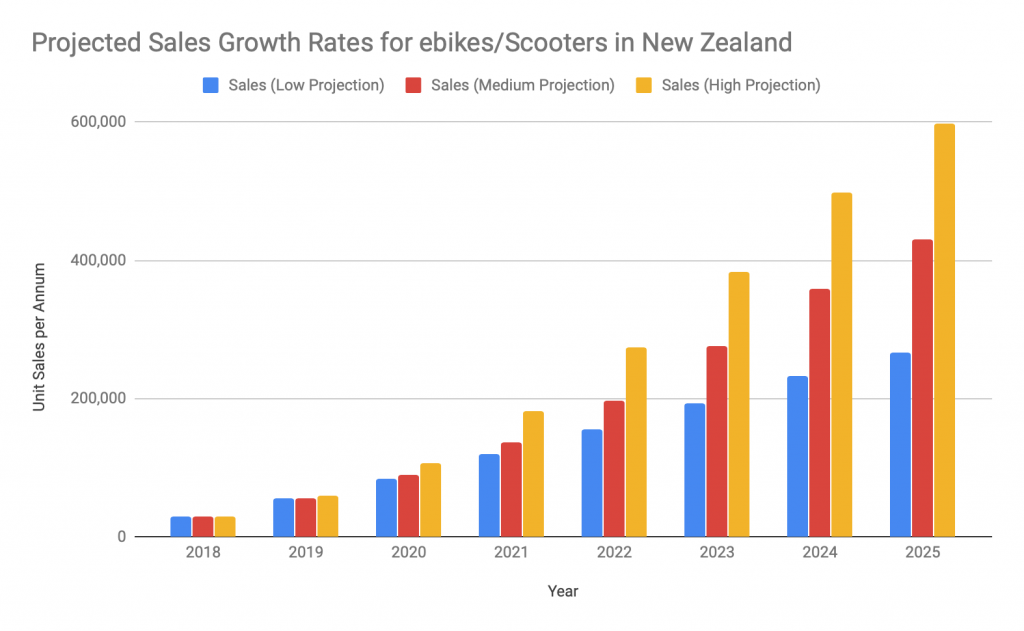
It’s easy to understand why.
They’re radically coming down in price: Decent e-scooters are now $600-1000, while electric bikes now have salary rebate and interest free finance schemes that bring the upfront costs down. For many, these vehicles replace the second car. For someone paying for parking in the city and commuting into the city from Tawa/Plimmerton/Porirua, changing to having a scooter/taking the train can save $7k a year even if they rent a car for a few days a month when they need it.
They flatten the steep Wellington terrain: with an average 300w motor in your scooter or e-bike, it’s like adding an extra few versions of yourself to assist with the riding, and more powerful versions are coming.
They’re the fastest overall solution for getting around: In New Zealand, 56% of the trips that we take are less than 5km. These smaller vehicles don’t have the hassles of finding and paying for parking and slip through car congestion. With a highly congested downtown in Wellington a lot of riders are switching to e-bikes because it’s simply the most fastest option.
If the Wellington region is to have its population’s shares of micromobilty vehicles (a reasonable assumption given lower car ownership and higher than average incomes) then that’d mean an additional 175,000 new ebikes/scooters by 2025.
If 30% if these were used for commutes, that’s an additional ~40,000 people using these vehicles (either directly, or in combination with public transport) to get into work each day. For context, that’s a 10x increase since 2013 and would put riding these vehicles at the same number of people currently coming into the city by train or bus COMBINED.
The best research we have in NZ cites safe cycling infrastructure as the biggest determinants as to whether people feel safe getting on a bike and riding into work.
In short, people want to use these vehicles, but they want to feel safe doing so.
So how are we doing in Wellington?
The council developed a Cycle Masterplan that was developed in 2015.
It was based on 2014 projections for cycling demand, done before we really understood the growth potential of these new electric modes.
It mapped out where we COULD put in better infrastructure, but punted building most of the big infrastructure near the city out to 2021-28 and the outer suburbs to post-2028.
Since then, they approved $74m of funding (of which $33m comes from NZTA) in the 2018-28 Long Term Plan to build connections from the CBD to Kilbirnie/Miramar, Mt Cook, Brooklyn and Newtown over the next 10 years.
It’s slower than needed. The world has changed, and the plan needs a rethink.
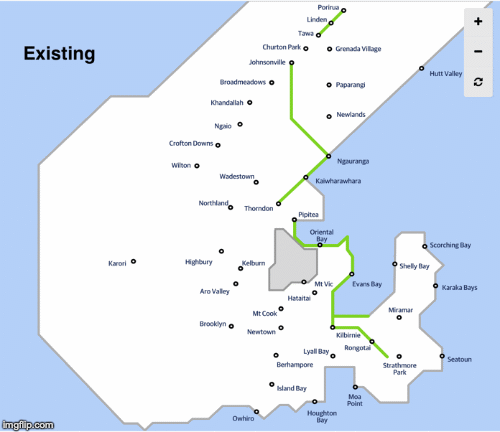
The Vision
The Let’s Get Welly Riding Vision is an ambitious vision of a network built to enable a less congested, more fun, accessible and cheaper-to-get-around city.
Importantly, the new vehicles augment our existing public transport.
So, what does it look like?
Actually pretty similar to the existing plan, just done sooner and better than was originally planned.

We propose bringing forward construction on major parts of planned Stage 3 (currently 2021-28) and Stage 4 (2028+) projects into a staggered Stage 3a and 3b plan to be completed in 2021-26, with all major pieces originally mapped out to be completed by 2028.
We also suggest the addition of a new set of cycleways not currently on the Masterplan:
-
- A ‘showcase’ Kelburn-City route via the beautiful Botanical Gardens
- A Wallace/Taranaki Street Connection (scoped but not currently included) going past Wellington High, the Massey campus and Toi Whakaari.
- An additional connection to Khandallah via Onslow Road.
- A connection to the airport from the existing network for employees and day passengers.
Key points about the Vision:
- We need to just get on and try things: Both LGWM and Newtown connections are progressing far slower than needed. Best practice globally for rolling out networks like this is to start with tactical urbanism trials and consult/adjust as we go, rather than the traditional drawn out design->consult->build paradigm. People give better feedback when they can see and feel what is possible rather than have to imagine it. Wellington’s considerable strengths in smart cities mean that we can measure and track trials in real time and then adjust the infrastructure as we learn.

- They need to be proper bike lanes: We advocate a higher standard for this network than was originally proposed. Most of the bike lanes we have today in Wellington are not bike lanes – they’re bike *lames*. Our rule of thumb: if you don’t feel safe letting your 5 year old daughter or your grandma ride on it, then it’s not a bike lane. We suggest that Wellington adopt the recently released Auckland Transport design standards.
- They need to be continuous: best practice globally states that the most effective networks are those that are connected. Riding along till you reach a pinch point isn’t satisfactory – it’s having a 4 lane motorway except for a small point where you have to transition to a 2 lane gravel road for 500m. It’s gotta go to the places people want, and safely.

- We need to focus on connecting to public transport: This Vision has a big focus on connecting with the train network. Metlink recently reviewed rules around scooters and bikes (section 9.1), and deliberately made them enabling to unlock multimodal travel. Scooters especially make it easy for people to ride to the station, hop on then ride into town at the other end.
- Connect the network to schools: these new vehicles are notable for their lack of licence requirements, and some of the biggest consumers of scooters has been younger folks. For teenagers, this can be the most cost-effective means of getting around. Let’s let them do this safely.
- Reallocating roadspace: We’re aware that we’re proposing routes that will require reallocating space on the road away from parking, especially from residents who currently park on arterial routes. This is a tradeoff that we’ll have to make, but it’s currently very underpriced real estate that if unlocked, will provide benefits for far more people than those who currently park there.
- It needs to be paired with other infrastructure improvements: the new network needs to be paired with bike/scooter parking infrastructure in our cities as well. EECA recently announced funding grants for secure storage facilities for ebikes, and complaints about shared scooters would be substantially reduced if they had dedicated parking and weren’t scattered on the footpath.
What benefits could we expect to see from this?
- Employees riding to work: from the current 2%, reducing congestion and lowering their costs of travel and parking.
- Kids riding to school: we can expect an increase in riding to school, countering the trend that has seen less than 2% bike today, a 6x decrease since 1990.
- More money in our pockets: transport is Kiwi’s third largest household expense and we have the highest levels of car ownership in the world. All the research from elsewhere suggests that this is the cheapest means of getting around on a per-km basis – meaning that we can help those in the community who need more affordable transport get around safely. See also this great presentation from London on the other benefits of cycling and walking.
- Cheaper rates
Why should we do this now?
We’re aware this is ambitious.
That said, we’re simultaneously facing both a climate emergency and an explosion in this form of low-emission, cheap, point-to-point transport that supports our public transport network, can be supported with cheap infrastructure and is causing headaches on our sidewalks.
If we’re going to make a smart bet on what to lean into for our transport future, this is it.
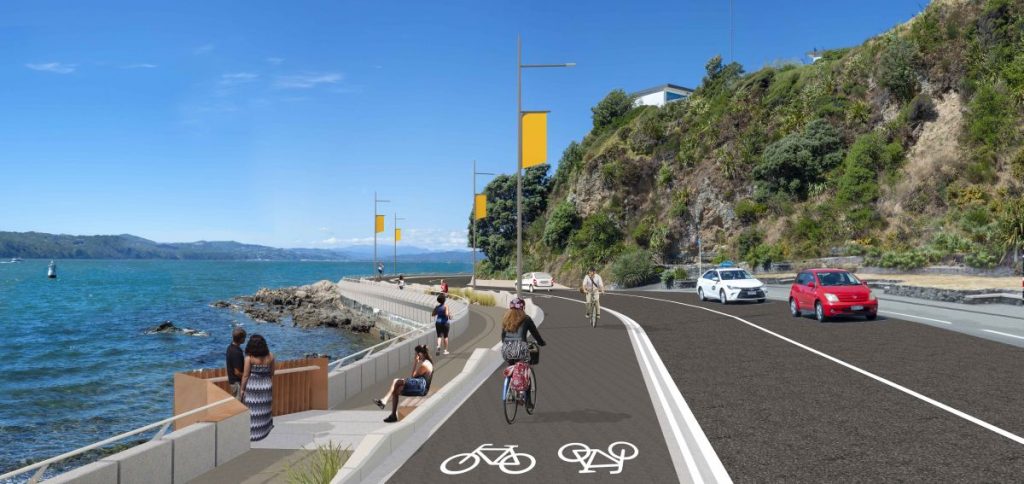
There’s a couple of compelling reasons why NOW is the time to act:
- These electric bikes and scooters are inevitable: they’re cheap to own, rapidly improving and very convenient. They’re growing at 100% a year at the moment. You might not like them, but they’re coming and it’s a question of how, not whether, to handle them.
- The public support for dedicated infrastructure is quickly shifting: the biggest e-bike demographic is 50+ yr old Boomers. They like them because they’re cost effective transport, keep them active and let them get up the hills they’d otherwise struggle on. Boomers vote, they want safe places to ride them, and they’re also worried about being hit by scooter users when they do walk. It also happens that 80% of Wellingtonians support building this infrastructure to reduce risk of crashes.
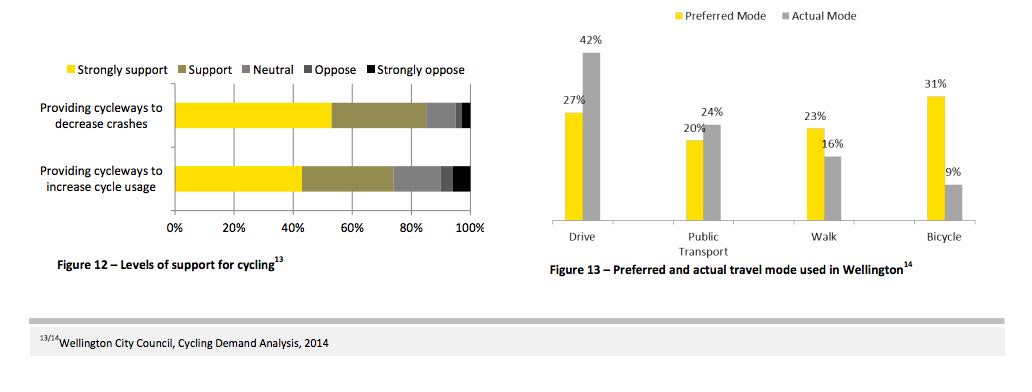
- There’s funding on the table: the next NZTA National Land Transport Programme had dedicated funding for improving safety of our roads. An ambitious programme that focuses on the safety benefits we’d unlock will position us well to unlock this funding.
- It’s rapid, high return infrastructure: In London, the Benefit Cost Ratio (how councils calculate whether an investment will pay for itself) for cycleways have been >13. With our Roads of National Significance, many had a ratio of <1, meaning they had a payback of less than a $1 for every $1 invested. Even the Recommended Programme for Investment for LGWM has an overall Benefit Cost Ratio of 0.6-1.7. Cycleways are low-hanging fruit – fast to implement and generate high returns.
- It’s congestion mitigation during Lets Get Wellington Moving: We’ve already got a lot of other activities planned for the next 10 years that will disrupt the city/cause an increase in congestion. Anything that we can do to accelerate this coming mode shift will help ease the pain during this period.
So how much will it cost?
When the council originally looked at the network in 2015, the total works were costed out for at around $100m.
But it was costed on inadequate infrastructure (ie a fair bit of paint on the road without any protection etc.) and some of the figures were way off. The proposed Oriental-Kilbrinie connection via Evans Bay Parade that is currently under construction was originally costed at $200,000 for 8.8km of painted bike lane, but then greenlighted for $10m because a proper separated cycleway was needed to connect Kilbirnie/Miramar etc safely.
It’s clear that we’ll need to rethink this as well.
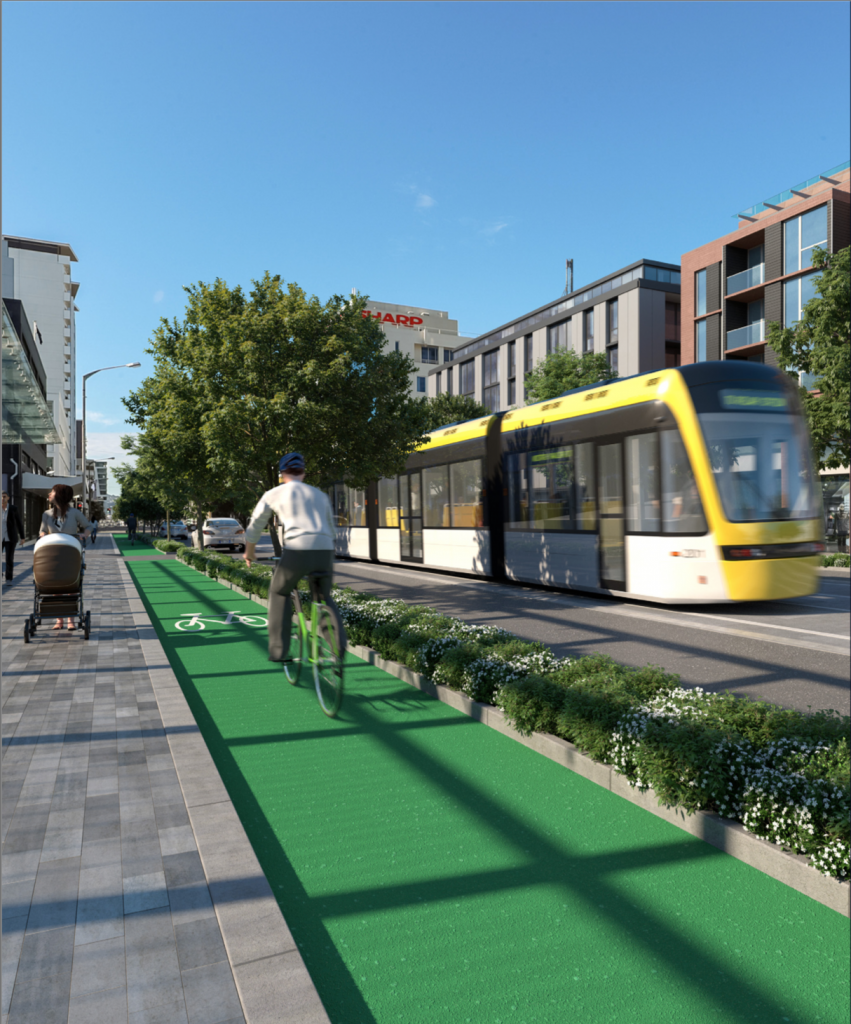
Infrastructure – visualisation from Let’s Get Wellington Moving
It largely depends on whether we implement separated bike lane construction (~$3.8m/km and take a 2-3 years to design/contract/build) or shoot for tactical urbanism options ($150k/km and quick to design/implement). With the 136km of routes in the Vision, we’ve split these up into core projects and tactical interventions that can prove the case/complete parts of the network.
We propose ~30km of temporary trial sections for 2019-2021 at a cost of around $5m, as well as more robust construction of 22km worth of cycleways for around $60m. For the later stages, we budget $90m for 2021-2023 and $140m in 2023-2026.
Spread over the next 10 years, that’d ramp from $20m a year in 2019-21 to $45m a year in 2023-26 for a total programme cost of around $390m. With a conservative BCR of 4, that’d unlock $1.56B worth of benefits.
There is already $30m of funding on the table for LGWM and the council has already budgeted $74.5m, so we’re looking at an increase of around $290m over existing spending. There’s more becoming available via the NZTA National Land Transport Programme for safety improvements.
For context, $400m is the same cost for a new lane in the Terrace tunnel and a little bit of widening of SH1 up to Ngauranga Gorge. For the cost of a single lane of additional traffic for a few km’s into the city (and no improvements to handle any of that congestion once they arrive), we’d have a fully functioning and comprehensive network to support hundreds of thousands of safe, cheap, fast trips every day.
Is that an investment worth making? We think so.
So, what would be the most logical next steps?
The Lets Get Welly Riding Vision is the start of a conversation. We intend for it to be something to point to, debate and discuss.
Here’s the specific ask:
- Sign the ActionStation petition to state that you support the Vision. The single biggest thing that we can do is show our support for bold action to Council so that they can make hard decisions.
Sign the Petition here!
- Post the 2028 Vision map on social media signalling your support, with a link to this blogpost.
- Vote in the upcoming local elections for councillors with willingness to build this kind of infrastructure and not just more roads.
With the local body elections coming up in October, we encourage you to approach your candidates with a challenge to endorse or critique this proposal.
Additionally, we are developing a presentation (with talking points) that you can use to present to groups, companies and communities relevant to you. We’ll do our first public presentation on this in October when Oliver is back from hosting The Micromobility Conference. More details to follow soon!
If you’re interested in finding out more, sign up to the Talk Wellington newsletter.
We’re designing this for Wellingtonians to take this and run (or ride, as the case may be).
We hope you are inspired and join us in making Welly the best place in the world to live!
Thanks to Isabella Cawthorn, Niels Hoe, Mette Hoe, Conor Hill, Mark Johnston, Kent Lundberg, Patrick Morgan, Leigh Hunt, Rob King, Regan Dooley, Catarina Gutierrez and Kathryn King for their invaluable feedback and insight.
Frequently Asked Questions
What about weather?
- Welly is windy and it rains. But it’s not as much as you’d think. In Wellington, there’s only 10% of the days of the year (or 2 days per working month) when it happens to be raining in the 8-9am bracket or the 5-6pm timeframe. If your timing is flexible and you can depart an hour before or after, the risk of rain within that period (that hour and adjacent hours) falls to 4.89%, or 1 day a month during the week. For these periods, you’d be able to either choose to make the trip in an alternative mode (car, PT or Uber/taxi) or suck it up knowing that it’s going to be a quick trip on the most cost effective transport mode available. It’s all about tradeoffs 😉
Won’t people still want their cars?
- Yes, and we expect that these vehicles won’t replace car ownership, just car use (at least initially). For when people do want to transition away from car ownership, we have excellent car share systems with Mevo and Cityhop and more which are rapidly expanding into suburbs outside the CBD, and a great Uber/taxi system.
[Ed: Sounds generally good? We think so too. There’s a petition to capture general supportive vibes, link here. Put your X on it now, and share! ]
Image credits:
Banner image by Pablo Gomes CC BY-NC-ND 3.0 NZ
GIF map: Oliver Bruce, Brett Skinner
Visualisation of infrastructure plus mass transit: Let’s Get Wellington Moving
Oriental Bay visualisation: Wellington City Council

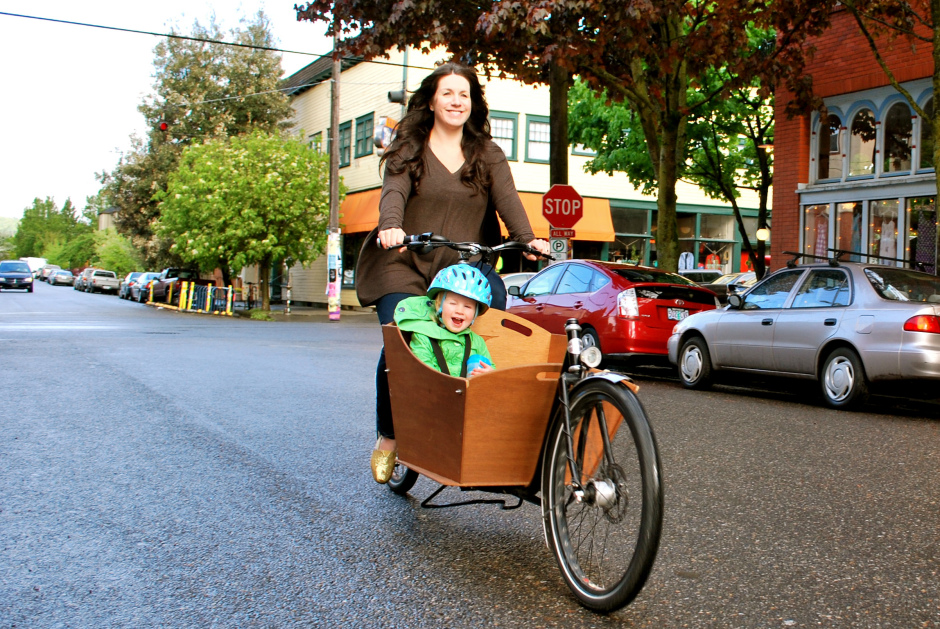

Congrats. This is excellent work and exactly what is needed. All power to you. Ambition should be even higher to meet Paris targets but that will come once the benefits of this scheme become obvious.